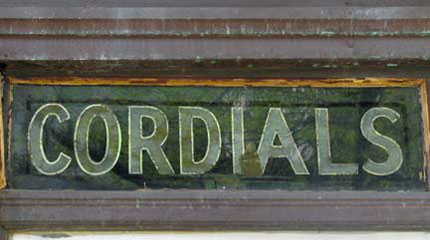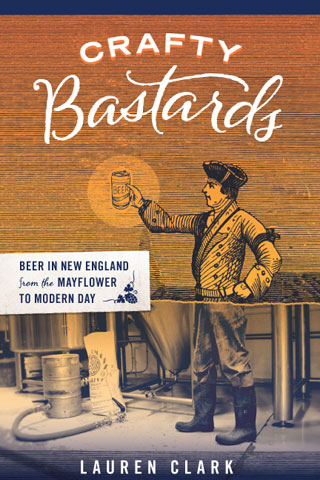November 5th, 2009
Cordial confusion

I got to thinking about Massachusetts’ peculiar “cordial license” recently after sitting down with Courtney Bissonnette to get a sneak peak at her cocktail menu for Coppa. The latest venture by prolific chef Ken Oringer is set to open in the South End any minute now and amp up the Italian enoteca concept the way Toro has done with Spanish tapas. Bissonnette will helm the bar program at both establishments, in which her husband, chef Jamie Bissonnette, is a partner.
Unlike Toro, which has a full liquor license, Coppa has a beer and wine license with a permit to serve cordials and liqueurs. So Bissonnette, collaborating with head bartender Corey Bunnewith (recently of Drink), devised a list of cocktails based on, yes, liqueurs like St. Germain and Cherry Heering, but also vermouths and other aromatized wines, Italian bitters like Aperol and Campari, and a splash of Plymouth Sloe Gin and Pimms No. 1. It includes an Aperol Spritz (Aperol, prosecco, soda) and a Lenny e Joan (Plymouth Sloe Gin, dry vermouth, Cynar, lime, orange zest, sugar rim). Creative, tasty-looking stuff, and, as Boston magazine recently pointed out, Coppa isn’t the only place making cocktails within the confines of a cordial license.
Which brings us to the question: just what are the confines of such a license? Well … no one really knows. “It was never spelled out in writing,” said a long-time member of Boston’s liquor wholesale industry who wishes to remain anonymous. This source — I’ll call him Stan — says that the license came about because of Italian-American drinking customs. Specifically, North End restaurateurs, who typically had beer and wine licenses, were miffed about getting busted periodically for offering their clientele a customary after-dinner shot of Sambuca or Strega. So, in 1994, the cordials and liqueurs permit was born. Stan connects this development to the growing clout of Italian politicians around that time. While I haven’t done the research to verify that claim, it is intriguing that 1994 marked the beginning of both the cordial license and Tom Menino’s long (and, since Tuesday, getting longer) tenure in the mayor’s office.
Anyway, the thing about the cordial license is that “cordial” and “liqueur” have been liberally defined. Most people — including liquor industry folk, says Stan — first assumed that the license referred only to sugary spirits flavored with various fruits and botanicals. But over the years, outliers snuck in. Grappa? Pisco? Check. Applejack? Check. Flavored vodka? Check. So … if you’re a grape-based spirit, and you want to be served under a cordial license, say you’re from anywhere but France. If you’re applejack, don’t worry; only about three people in the city know what you really are (70% grain neutral spirit — woo hoo!). And if you’re vodka, just infuse yourself with kiwi or something to make yourself seem cute and harmless as a bunny, even though you’re sugarless and 80 proof.
It all adds up to one very grey area, where some spirits attract scrutiny and others don’t. Grappa is an example of the former, and therefore is typically served on the sly, according to Stan. It is actually up to the wholesale companies to decide what they are and aren’t allowed to sell to establishments with cordial licenses. And they all do so individually, says Stan, so there tends to be some variation in product listings. A restaurateur might be able to get, say, applejack through one wholesaler but not another.
While a full liquor license is almost always going to be the most desirable type of license, mixologists can get pretty creative with a cordial license. And, presumably, these licenses are cheaper and easier to get than full licenses, which are strictly capped and therefore so coveted that corruption regularly ensues. Liquor laws are weird in a sometimes cool way. I love that a special provision created to accommodate the customs of an influential ethnic group has spawned creative bars that are mixing interesting drinks with unusual ingredients. And it’s nice knowing that if I go to a place like Coppa and I’m not in the mood for a mixed drink, I can get a nice, civilized, 110-proof shot of green Chartreuse.
Permalink | Filed under Applejack, Liqueur, Pisco, Vermouth | Tags: Coppa, cordials, liquor license, Massachusetts liquor laws

November 5th, 2009 at 7:57 pm
Cordial licenses also bring out the very, very worst in cocktail menus. While X-tinis might be bad, some of the utter shit that I’ve seen on cordial-only menus (hello Savant Project, I mean you) make me absolutely yearn for a cosmo with an appletini back.
Courtney, fortunately, knows better. I might have to indulge in a little bitter bastard tonight (can you find those in Burlington, VT?) in her honor.
November 6th, 2009 at 12:59 am
I used to be the bar manager at the now defunct zon’s in JP (we had a cordials license) and found this cocktail list that I had put together a few years back. The cocktail names were inspired by songs or band names. I was able to get Fernet back then; is that still the case? Courtney: I’d be honored if you wanted to use any of them.
mod lang:
pisco | cointreau | lemon | house grenadine
blonde redhead:
van gogh pomegranate & citroen vodka | cointreau | fresh lime
communist daughter:
van gogh oranje | punt e mes | campari
jack ruby:
apfel jack | ruby port | pineapple juice
village green:
muddled mint & sugar | brandy | soda water
dean martinez:
citrus rum | dry vermouth | orange bitters
stormy weather:
citrus rum | ginger beer | coke splash
bitters end:
shot of fernet branca | ginger ale; mix , shoot & chase or sip; a perfect digestive
November 6th, 2009 at 7:59 pm
Very interesting topic. I’ve often wondered why some places could sell certain spirits and others couldn’t, despite the fact that both had a cordials license. I’ve been aware that there’s a two-tier system, but there still seems to be a lot of ambiguity. I’m going to start digging into the details more often when I go out. It would be great to hear from more industry folks on their nitty gritty interpretation of the laws and how they impact their establishments.
November 7th, 2009 at 1:48 pm
Great topic! I’ve noticed plenty of instances of cordial license “interpretation” that probably exceeds the, ahem, spirit of the law. Brandy, flavored vodka, and yes, the grappa-based Fernet all seem kinda pushing it in my book, but I never call attention to these places for fear of ratting them out. It’s hard enough to get by these days without ABCC breathing down your neck for reasons other than serving minors. On the other hand, I guess a competitor has reason to object if they’ve paid the hefty price for a full-liquor license and the guy across the block is getting by on a much-cheaper cordial license.
November 10th, 2009 at 3:08 pm
True, k., true. What the hell is a bitter bastard? Dannyvee, thanks for the shout-out from the now-defunct Zon’s. A lot of people miss that place.
November 11th, 2009 at 8:16 am
Ah, the Little Bitter Bastard: one part each Luxardo Amaro, Campari, and Gin (I use Beefeaters), chilled. Probably garnished with an orange twist but I never seem to have oranges when I need them. Courtney put one in front of me when she was at #9; I’m not sure if it’s her drink or not but I always associate it with her (and fondly). The name, so far as e. & I can remember, is mine; it might have a real name that I’m unaware of (but I doubt it’s as evocative as LBB!).
I regret to say that these are not available in Burlington (but the easy availability of growlers of Magic Hat’s “American Sour” made up for that).